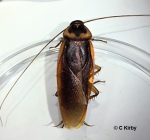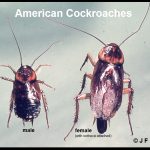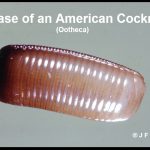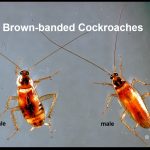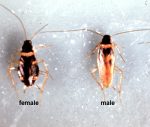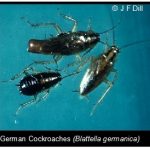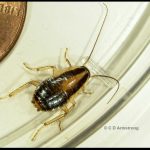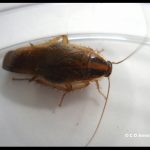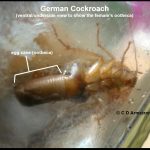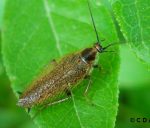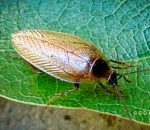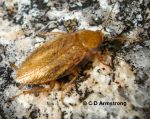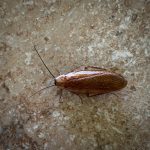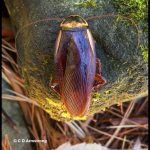Cockroaches (including Wood Roaches)
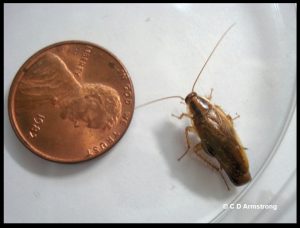
Cockroaches generally have a flattened, oval appearance, long spiny legs and long antennae. Color, which depends on species and age, ranges from a reddish brown to dark brown and from tan to black. The German cockroach (pictured at right as well as below) is by far the most likely species to infest homes in Maine. It is about 1/2-inch long, light brown, with two lengthwise black stripes on the shield behind its head. The adults are fully winged, but rarely fly. The nymphs resemble the adults but are wingless and are generally smaller (early-instar nymph example at BugGuide.net)
Due to its size (up to 2″ long), the American cockroach is the species most likely to be recognized in Maine (see link and first photo below). American cockroaches may be found in any room of the house.
Although cockroaches carry disease organisms, they are not known to transmit disease to humans. They do contaminate food and kitchen utensils with excrement and salivary secretions, leaving an unpleasant odor.
There is also a type of cockroach that lives outdoors in wooded/forested habitats and feeds on decaying organic matter. These are known as wood cockroaches or sometimes just wood roaches, for short (see below for some examples). They are very common in Maine and the Northeast, and can be a nuisance when they end up indoors as ‘accidental invaders’ (which happens often during the summer months in New England). The males have fully functional wings and since they are also attracted to lights at night, they consequently tend to be encountered by people far more often compared to the females. Fortunately, wood roaches cannot sustain or establish themselves indoors.
Additional Information:
- Cockroaches (UMaine Extension Pest Management Fact Sheet #5011)
- Brown-banded Cockroaches (Penn State)
- German Cockroach (Penn State)
- American Cockroach
- Wood Cockroaches (normally found outdoors–their natural habitat–in moist, woodland areas but often they enter homes and other buildings as “accidental invaders”)
- Pennsylvania Wood Roach – Parcoblatta pennsylvanica (Penn State)
- Fulvous Wood Cockroach – Parcoblatta fulvescens (BugGuide.net)
- Virginia Wood Cockroach – Parcoblatta virginica (BugGuide.net)
- Dusky Cockroach – Ectobius lapponicus (BugGuide.net)
- Spotted Mediterranean Cockroach / Tawny Cockroach – Ectobius pallidus (BugGuide.net)
- American Cockroach (female)
-
American Cockroaches
(Male versus Female)
- Egg Case (Ootheca) from an American Cockroach
- Brown-banded Cockroaches (female: left; male: right)
- Brown-banded Cockroaches
- German Cockroaches
- German Cockroach (nymph) (Bangor, ME; 3/24/2022) (pictured with a portion of a US penny to convey a sense of the size)
- Female German cockroach with ootheca (egg case) attached to her abdomen
- Ventral view of a female German cockroach, revealing her egg case called an ootheca
- Example of a wood roach (Dusky Cockroach, Ectobius lapponicus) (male) (Stetson, Maine; 7/13/2015)
- Dusky Cockroach (Ectobius lapponicus) (a type of wood roach that lives outdoors) (male) (Stetson, Maine; 6/19/2018)
- Example of a wood roach (Tawny Cockroach, Ectobius pallidus) (male) (Acadia National Park, Maine; 10/11/2009)
- Example of a male Virginia Wood Cockroach (Parcoblatta virginica) (Naples, ME; 6/26/2024) (Photo courtesy of M. Shepard)
- Australian Cockroach (Periplaneta australasiae) (Bath, ME; 10/17/2025) (a very rare visitor/hitchhiker to Maine; prefers/requires tropical and subtropical climates — warm, damp places outdoors or sometimes inside structures with those same conditions, e.g. greenhouses) (similar to the American cockroach; same genus)

